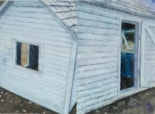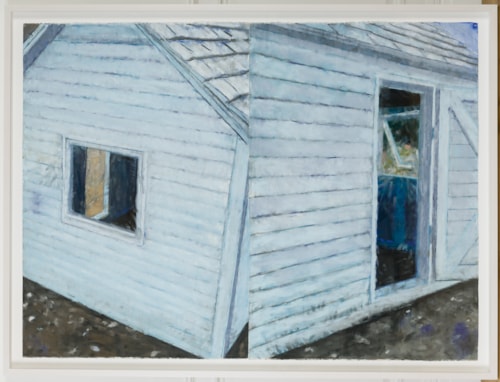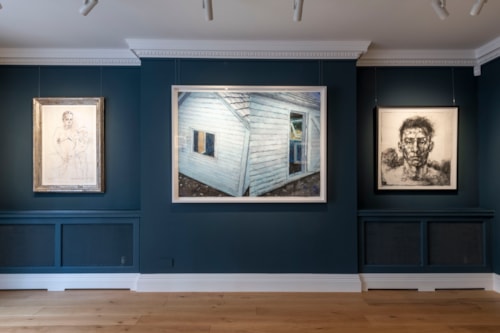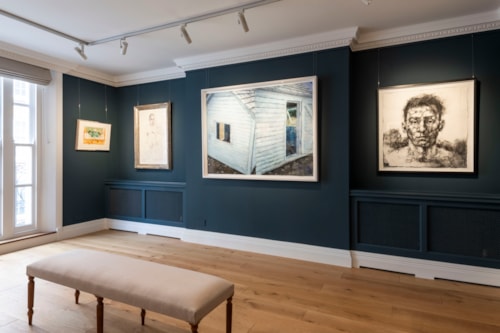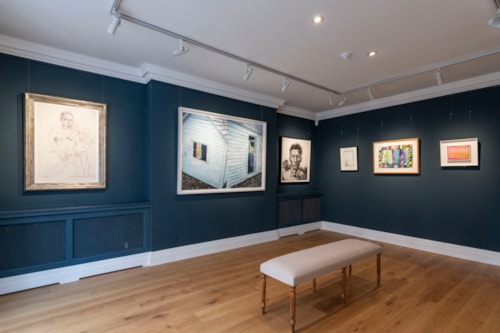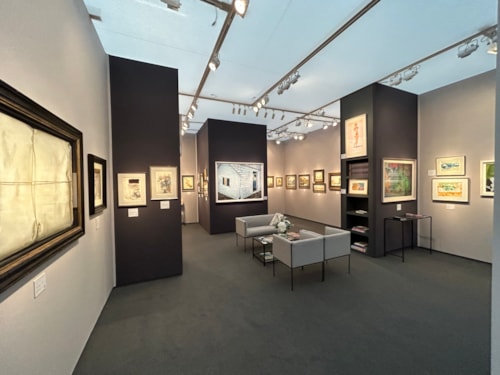Jennifer BARTLETT
(Long Beach 1941 - Amagansett 2022)
Old House Lane, No.1
Pastel on two sheets of paper.
1120 x 1525 mm. (44 1/8 x 60 in.)
1120 x 1525 mm. (44 1/8 x 60 in.)
A gifted draughtsman, Jennifer Bartlett was fond of working in pastels, particularly from the 1980s onwards. Drawn in 1986, the present sheet is the first of a series of large-scale pastel works, entitled Old House Lane, executed that year. Although houses (along with gardens, pools, the sea, and boats) had been a recurring motif in Bartlett’s paintings since the early 1970s, the structure depicted in this work is more specifically derived from the artist’s 1984 commission for the Volvo headquarters in Sweden. The Volvo scheme was made up of several site-specific elements, part of which was a freestanding ‘sculpture’ of ‘a small, square one-room house in the indigenous style of a Swedish summer cabin – with white-painted vertical clapboards, a copper roof and dirt floor.’ In the years following the Volvo project, Bartlett created similar three-dimensional sculptures of clapboard houses which were paired with paintings of the same motif; examples of these hybrid works are today in the Honolulu Museum of Art and the artist’s estate.
The present sheet, together with the rest of the Old House Lane series of pastels, was exhibited at the Paula Cooper Gallery in New York in 19874. As the critic John Russell noted, in a lead review of the exhibition in The New York Times, ‘Like almost all her best work, Jennifer Bartlett’s new pastels at the Paula Cooper Gallery, 155 Wooster Street, are a mix of symbolism and autobiography. Large in scale and confident in tone, they fill the entire gallery without any flagging of energy. Fundamentally they are made up of the same three disparate elements, combined and re-combined in a landscape that she got to know a year or two ago on the North Shore of Long Island. The elements in question are a boat, a house and a white picket fence. It is not clear that the little vessel has ever raised sail, let alone been to sea, and it may even be that it is primarily a sculpture, rather than a functioning boat. Nor is it clear that anyone could live in the house - first, because it is too small, and second, because it is still some way short of habitability. The fence is a fence, all right, and it comes with a fine big lock, but once again we are not quite sure what is being fenced in (unless it is, perhaps, ourselves). Veteran Bartlett-watchers will know that no matter how enigmatic their form, these three elements are enrolled in the service of a powerful and idiosyncratic imagination…They make a sturdy and eminently pictorial trio, but they also have an emblematic role, in that the boat stands for all boats, the house for all houses, the fence for all fences. They have strong American associations...The house is clapboard, painted white, like a million others. The fence is plain, but not dainty. Here and there, a stretch of dune, peppered with long grasses, gives the location away. It is a scene untouched by human presence. No footprint marks the sand. No mail has been left for the windowless house. No swimsuit dries on the prow of the boat. Seeing no empty cans, no garbage bags, no copies of last week's newspapers, we decide that the boat, the house and the fence are a self-sufficient community that leads its own life and sees humankind as irrelevant.’
As Russell’s review of the 1987 Old House Lane exhibition continues, ‘It could be that one or two images would give us the whole story, but that is not Ms. Bartlett’s way. Shifts of scale, weather and abutment give the show a continuous variety. All three elements appear sometimes as monumental presences, sometimes as delicate evocations silvered by moonlight. If the name of “pastel” suggests to you a furry, powdery, vulnerable presence, you can set that idea aside. Ms. Bartlett’s pastels are strong and plain in their execution...We do not have to pore over them, fearful that if we lean on the glass case they will turn to dust. They hold the eye from a considerable distance and have an almost architectonic quality. By adopting a mainline representational idiom, Ms. Bartlett may seem to many visitors to be carrying on an American tradition that goes way back to Homer and Sargent and has had many a gifted exponent since. And her pastels can, undeniably, be read and enjoyed on those terms. But their real hold upon us comes from the extent to which the boat, the house and the fence are metaphors not only for human archetypes that will be with us for all eternity but for a menage a trois that turns out, against the odds, to work well.’
The composition of Old House Lane, No.1 is, like many of Bartlett’s paintings, divided into two distinct parts. When asked in a recent interview why the diptych format appealed to her, the artist replied, ‘Ever since I was little I have thought that two are better than one. Not in terms of people, just in terms of looking at something. I like seeing things kind of “off” and from different points of view. The diptychs border on abstraction, even the figurative ones. The two panels create discord within the images themselves.’
Another large pastel drawing by Jennifer Bartlett from the 1986 Old House Lane series is today in the collection of the Brooklyn Museum, while two others were later included in the 1988 exhibitionRecent American Pastels in Middlebury College, Vermont. Most of the other Old House Lane pastels have remained in private collections since the 1987 Paula Cooper exhibition, although a handful of works from the series have appeared at auction in recent years.
The present sheet, together with the rest of the Old House Lane series of pastels, was exhibited at the Paula Cooper Gallery in New York in 19874. As the critic John Russell noted, in a lead review of the exhibition in The New York Times, ‘Like almost all her best work, Jennifer Bartlett’s new pastels at the Paula Cooper Gallery, 155 Wooster Street, are a mix of symbolism and autobiography. Large in scale and confident in tone, they fill the entire gallery without any flagging of energy. Fundamentally they are made up of the same three disparate elements, combined and re-combined in a landscape that she got to know a year or two ago on the North Shore of Long Island. The elements in question are a boat, a house and a white picket fence. It is not clear that the little vessel has ever raised sail, let alone been to sea, and it may even be that it is primarily a sculpture, rather than a functioning boat. Nor is it clear that anyone could live in the house - first, because it is too small, and second, because it is still some way short of habitability. The fence is a fence, all right, and it comes with a fine big lock, but once again we are not quite sure what is being fenced in (unless it is, perhaps, ourselves). Veteran Bartlett-watchers will know that no matter how enigmatic their form, these three elements are enrolled in the service of a powerful and idiosyncratic imagination…They make a sturdy and eminently pictorial trio, but they also have an emblematic role, in that the boat stands for all boats, the house for all houses, the fence for all fences. They have strong American associations...The house is clapboard, painted white, like a million others. The fence is plain, but not dainty. Here and there, a stretch of dune, peppered with long grasses, gives the location away. It is a scene untouched by human presence. No footprint marks the sand. No mail has been left for the windowless house. No swimsuit dries on the prow of the boat. Seeing no empty cans, no garbage bags, no copies of last week's newspapers, we decide that the boat, the house and the fence are a self-sufficient community that leads its own life and sees humankind as irrelevant.’
As Russell’s review of the 1987 Old House Lane exhibition continues, ‘It could be that one or two images would give us the whole story, but that is not Ms. Bartlett’s way. Shifts of scale, weather and abutment give the show a continuous variety. All three elements appear sometimes as monumental presences, sometimes as delicate evocations silvered by moonlight. If the name of “pastel” suggests to you a furry, powdery, vulnerable presence, you can set that idea aside. Ms. Bartlett’s pastels are strong and plain in their execution...We do not have to pore over them, fearful that if we lean on the glass case they will turn to dust. They hold the eye from a considerable distance and have an almost architectonic quality. By adopting a mainline representational idiom, Ms. Bartlett may seem to many visitors to be carrying on an American tradition that goes way back to Homer and Sargent and has had many a gifted exponent since. And her pastels can, undeniably, be read and enjoyed on those terms. But their real hold upon us comes from the extent to which the boat, the house and the fence are metaphors not only for human archetypes that will be with us for all eternity but for a menage a trois that turns out, against the odds, to work well.’
The composition of Old House Lane, No.1 is, like many of Bartlett’s paintings, divided into two distinct parts. When asked in a recent interview why the diptych format appealed to her, the artist replied, ‘Ever since I was little I have thought that two are better than one. Not in terms of people, just in terms of looking at something. I like seeing things kind of “off” and from different points of view. The diptychs border on abstraction, even the figurative ones. The two panels create discord within the images themselves.’
Another large pastel drawing by Jennifer Bartlett from the 1986 Old House Lane series is today in the collection of the Brooklyn Museum, while two others were later included in the 1988 exhibitionRecent American Pastels in Middlebury College, Vermont. Most of the other Old House Lane pastels have remained in private collections since the 1987 Paula Cooper exhibition, although a handful of works from the series have appeared at auction in recent years.
Active as a painter, draughtsman, printmaker and writer, Jennifer Losch Bartlett was born in California and studied at Mills College in Oakland and at the Yale School of Art and Architecture in New Haven, graduating in 1965. In the late 1960s she began painting on uniformly-sized small steel plates (‘She wanted a simple, flat, uniform surface to paint on, a surface that did not require wooden stretchers, canvas, and all the bothersome paraphernalia of oil paint’, as one writer has noted), and had her first solo exhibitions of these works in New York in 1970 and 1972. Two years later the artist began a long and fruitful association with the Paula Cooper Gallery in New York, although in later years she also worked with other galleries, notably the Locks Gallery in Philadelphia.
Bartlett first came to prominence when her monumental work Rhapsody - made up of 987 painted steel plates, each one-foot square, and arranged in 141 vertical rows of seven plates each - was exhibited in 1976 at the Paula Cooper Gallery to considerable critical acclaim, and was quickly sold to a private collector. (The 153-foot-long painting is now in the collection of the Museum of Modern Art in New York.) Bartlett continued to produce works in series for much of her later career, notably the sequence of some two hundred drawings, executed in various media, entitled In the Garden and done between 1979 and 1980, and the twenty-four paintings of the Air: 24 Hours series, painted between 1991 and 1992. She also began working on print projects, once again often executed in series, such as an assemblage of screenprints and colour woodcuts entitled At Sea, Japan, which appeared in 1980.
Working between studios in Manhattan (and later Brooklyn) and Amagansett on Long Island, Bartlett continued to be very productive throughout her career. She also undertook a number of specific commissions for large-scale decorative work, notably for the Federal Building in Atlanta, Georgia, the AT&T Building in New York, the Institute for Scientific Information in Philadelphia, the Volvo corporate headquarters in Gothenburg in Sweden and the home of the collector Charles Saatchi in London. Bartlett’s paintings have been exhibited at the Venice Biennale, Documenta in Kassel and at the Whitney Biennial in New York, and the artist was elected to the National Academy of Design in 1990. Works by Bartlett are today in the collections of numerous museums throughout America, as well as in Australia, Bermuda, Britain, Denmark, Israel, Japan and South Korea. Museum surveys of her work have been held at the Walker Art Center in Minneapolis in 1985, the Museum of Modern Art in New York in 2011, and the Pennsylvania Academy of Fine Arts in Philadelphia and the Parrish Art Museum in Water Mill, New York in 2013-2014.
Bartlett first came to prominence when her monumental work Rhapsody - made up of 987 painted steel plates, each one-foot square, and arranged in 141 vertical rows of seven plates each - was exhibited in 1976 at the Paula Cooper Gallery to considerable critical acclaim, and was quickly sold to a private collector. (The 153-foot-long painting is now in the collection of the Museum of Modern Art in New York.) Bartlett continued to produce works in series for much of her later career, notably the sequence of some two hundred drawings, executed in various media, entitled In the Garden and done between 1979 and 1980, and the twenty-four paintings of the Air: 24 Hours series, painted between 1991 and 1992. She also began working on print projects, once again often executed in series, such as an assemblage of screenprints and colour woodcuts entitled At Sea, Japan, which appeared in 1980.
Working between studios in Manhattan (and later Brooklyn) and Amagansett on Long Island, Bartlett continued to be very productive throughout her career. She also undertook a number of specific commissions for large-scale decorative work, notably for the Federal Building in Atlanta, Georgia, the AT&T Building in New York, the Institute for Scientific Information in Philadelphia, the Volvo corporate headquarters in Gothenburg in Sweden and the home of the collector Charles Saatchi in London. Bartlett’s paintings have been exhibited at the Venice Biennale, Documenta in Kassel and at the Whitney Biennial in New York, and the artist was elected to the National Academy of Design in 1990. Works by Bartlett are today in the collections of numerous museums throughout America, as well as in Australia, Bermuda, Britain, Denmark, Israel, Japan and South Korea. Museum surveys of her work have been held at the Walker Art Center in Minneapolis in 1985, the Museum of Modern Art in New York in 2011, and the Pennsylvania Academy of Fine Arts in Philadelphia and the Parrish Art Museum in Water Mill, New York in 2013-2014.
Provenance
Paula Cooper Gallery, New York, in 1987
John C. Stoller & Co., Minneapolis, in May 1987
Private collection
Anonymous sale, New York, Sotheby’s, 25 September 2018, lot 250
Private collection.
John C. Stoller & Co., Minneapolis, in May 1987
Private collection
Anonymous sale, New York, Sotheby’s, 25 September 2018, lot 250
Private collection.
Exhibition
New York, Paula Cooper Gallery, Jennifer Bartlett: Old House Lane, February - March 1987; New York, Marianne Boesky Gallery, The House was Quiet and the World was Calm: Jennifer Bartlett 1970-2014, November - December 2019.


